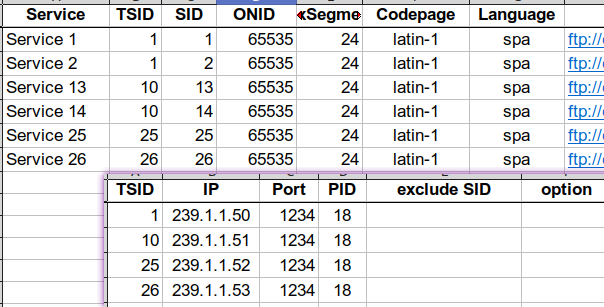Meshed configuration
The EIT output for a specific transport stream contains schedule information for services transmitted in this transport stream, the actual services. As long as the viewer is watching those services, he will receive only EPG related to these services. As soon as the viewer will try to get EPG for other services, there will no data. Why? The EIT in this transport stream contains no schedule information for other services. He needs to first swap to one of the services in the other transport streams. In practice, TV sets and IRDs cache schedule information across all services. But int without swapping over those services there is data to be cached. Such a configuration where only EPG data for services in the actual transport stream are generated is called NOMESH mode.
cherryEPG by default generates Full meshed EIT output. This means that every output EIT contains schedule information for actual and ALL other services. This behavior can be overridden for every output EIT. By listing ‘SID’s in the exclude_SID column, it is possible to disable specific event information.
Let’s take a look at a sample network configuration below:
Let us assume that there are 6 independent and different TV services. Two of them (1&2) are distributed over a DVB-C carrier QAM1. Two (13&14) are distributed in the same cable network, but on a different carrier QAM10. Services 25 and 26 are intended to be distributed over IP. Of course, a single cherryEPG installation can handle all of this.

EIT building modes
When we use following configuration

scheme file in default mode
we get the result which is shown in the column EPG generating default FULL MESH. Every output stream (we will have 4 of them) would contain EPG data for the services in each stream, the actual services and EPG data for services in other streams. This is as it should be. When the viewer is watching services 1 and presses the Guide button, it will show him EPG data for the services in the actual stream he is tuned to, as well as for services in other streams he can receive. There is only one minor drawback. The user will see also EPG data for services distributed over IP. This is probably not what we have in mind. So, how can we prevent EPG data for service 25 & 26 to appear on the cable network.
The solution is in the exclude SID functionality. Here we list SID numbers which we do not want to appear in the output table.

scheme file using exclude SID
The result of this can be seen in the column EPG generating by using exclude SID. Now every viewer will see only EPG for services he receives and we also save bandwidth as the EIT are smaller.
The third mode for generating EIT is by using the NOMESH option. This option can be switched on per output EIT.

scheme file with NOMESH
In the rightmost column EPG generating by using NOMESH we see that every output stream contains only EPG data for the actual services of the stream. This is the most economic EPG variant, as we save as much bandwidth as possible.